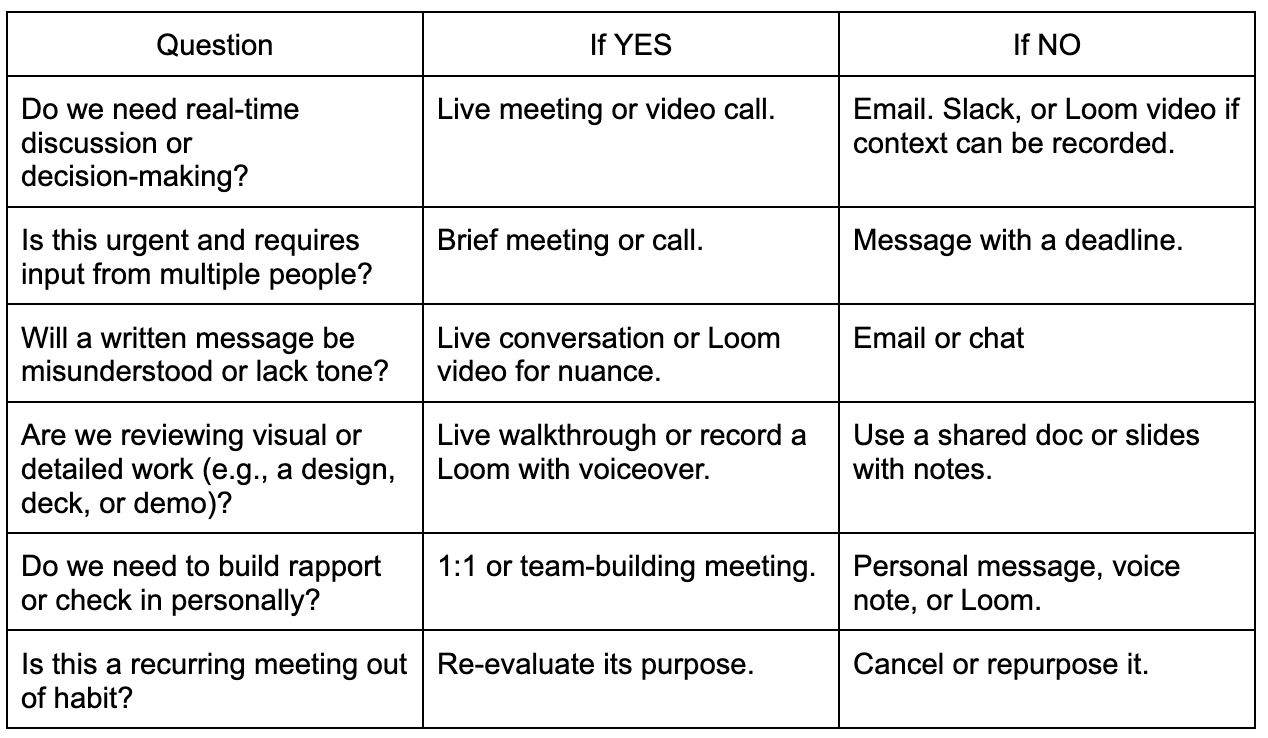How to Run Effective Meetings That Boost Productivity by 15%

Jesse Wisnewski


Management
Effective meetings help teams align, make decisions, and build momentum. But even with the best intentions, some meetings can feel unclear or unfocused.
Research shows that only 30% of meetings are considered productive, and just 37% follow a clear agenda, underscoring a widespread problem in meeting design. That doesn’t mean people aren’t trying. It simply highlights a common challenge: Most of us haven’t been taught how to design meetings that consistently work.
The encouraging news is that simple tools can make a big difference. The Interaction Method, tested in over 10,000 real-world sessions and from the book How to Make Meetings Work, has improved meeting productivity by about 15 percent. It focuses on clear goals, shared roles, and consistent follow-up. These small shifts can help meetings feel more focused, collaborative, and worthwhile.
In this post, you’ll learn how to:
- Decide whether a meeting is the right choice
- Match your meeting format to your goal
- Lead with clarity whether in person or remote
- Avoid common pitfalls with simple, flexible practices
If you want to make your next meeting more effective and engaging, this guide is for you.
Do You Even Need a Meeting?
Not every update or decision needs a meeting. Sometimes a clear message or short video is enough. It can save time and help your team stay focused on the work that matters most.
Before sending a calendar invite, pause and ask what you’re trying to accomplish. That small step helps set everyone up for a better outcome.
Here are five common types of meetings and when to use them:
1. Decision-Making Meetings
These are for when a group needs to choose between options. Best when several voices need to be heard before making a decision.
Tip: Share background information ahead of time so people come prepared.
2. Information-Sharing Meetings
These are used to give updates or share news. Best when the group needs to hear the same message and may have questions.
Tip: If there’s no need for discussion, a message or short video may work better.
3. Brainstorming or Strategy Sessions
These are for generating ideas or making a plan. Best when fresh input and collaboration can help move things forward.
Tip: Even creative meetings benefit from a simple structure and clear goal.
4. One-on-One Meetings
These are personal check-ins between managers and team members. Best when the focus is feedback, coaching, or building trust.
Tip: Keep these relational. Talk about what matters, not just what’s on the task list.
5. Team-Building Meetings
These are designed to help people connect and build culture. Best when there’s a clear reason to gather and time to be present.
Tip: It doesn’t have to be flashy. Simple and sincere usually works best.
Taking a few moments to choose the right kind of meeting, or deciding a meeting isn’t needed, can save your team hours over time. It’s one of the easiest ways to lead with clarity and care.
Use This Quick Guide Before You Hit “Send Invite”
Every meeting takes time, attention, and energy. That’s why it’s worth asking a few simple questions before adding something to the calendar.
This quick guide can help you decide if a meeting is the right move or if a message might serve your team better.

Good leaders protect people’s time by choosing the right format for the moment. Sometimes that’s a focused meeting. Other times, it’s a thoughtful message, a recorded video, or a shared document.
The goal isn’t fewer meetings. The goal is better ones.
How to Lead an Effective In Person or Remote Meeting
Once you’ve decided a meeting is the right step, the next challenge is making that time count. Meetings that are thoughtful, structured, and clear do more than respect people’s time. They build trust and move the work forward.
The practices below are rooted in the Interaction Method, a facilitation model introduced in How to Make Meetings Work by Michael Doyle and David Straus. This method was tested in more than 10,000 real-world meetings and helped teams increase productivity by about 15 percent. These tools are simple but require thoughtful leadership.
Here’s how to make your meetings more effective without adding complexity.
1. Start with a Clear Purpose
Every meeting needs a reason. What decision needs to be made or what context needs to be shared? When everyone knows why they are gathering, the meeting is more likely to stay focused.
2. Share a Time-Sensitive Agenda
Send the agenda in advance. Begin the meeting by reviewing it with the group and adjusting if priorities have shifted. Assign time limits to each item so discussion stays on track and people know what to expect.
3. Define Roles Clearly
Clarity builds confidence and helps people engage more effectively.
- Facilitator: Guides the discussion and helps maintain balance. This can be the person who called the meeting or someone else suited for the task.
- Recorder: Keeps track of key decisions and next steps. This role does not need to be formal. It might be the organizer jotting notes with a pen and paper, which I find more focused than relying on AI tools. I share more about that here.
- Participants: Speak with intention. Listen carefully. Stay on topic and support a shared outcome.
4. Focus on One Problem at a Time
Instead of bouncing between topics, stay with one issue until there is clarity or resolution. The Interaction Method highlights this as a key to productivity. Groups make more progress when they stay with a problem long enough to work through it together.
5. Document Decisions in Real Time
Don’t wait to write things down later. Record key agreements and action steps during the meeting so nothing gets lost. This becomes your group memory and prevents repeat conversations.
6. Start and End on Time
Honor the time people set aside. Beginning on time encourages focus. Ending on time shows you respect the rest of their day. If more discussion is needed, schedule a follow-up instead of running over.
7. Take One Minute to Reflect
Before closing, ask a quick question like, “What worked well today?” or “What could be better next time?” These short evaluations help you improve future meetings without needing to add more meetings.
8. Follow Up Promptly
Send a brief recap soon after the meeting. Include what was decided, who owns what, and what happens next. This helps people stay aligned and shows that the meeting mattered.
Effective meetings don’t happen by accident. With a clear plan and a few simple habits, you can turn meeting time into real progress. Lead with purpose, stay focused, and follow through.
Why Meetings Fail (and How to Avoid It)
Most meetings fall short for simple reasons:
- The purpose isn’t clear
- Too many people are involved
- One voice dominates the conversation
- No one captures key decisions or action steps
- There’s no follow-up after the meeting ends
In a recent study by Grammarly, 57 percent of employees said unclear communication holds back their productivity. When meetings lack purpose or stretch on without resolution, people start to disengage. They may still show up, but they stop leaning in.
Whether you’re meeting in person or on Zoom, clarity and stewardship matter. Psalm 90:12 reminds us to “number our days that we may get a heart of wisdom.” Time is limited. Using it well starts with how we gather.
Over to You
Effective meetings are built, not assumed. When you lead with purpose, share clear expectations, and follow through, you create space for people to do their best work together.
You don’t need more meetings. You need better ones. The tools in this post can help you make that shift, one calendar invite at a time.
Respect the time. Clarify the purpose. Lead with care. That is how real progress begins.












